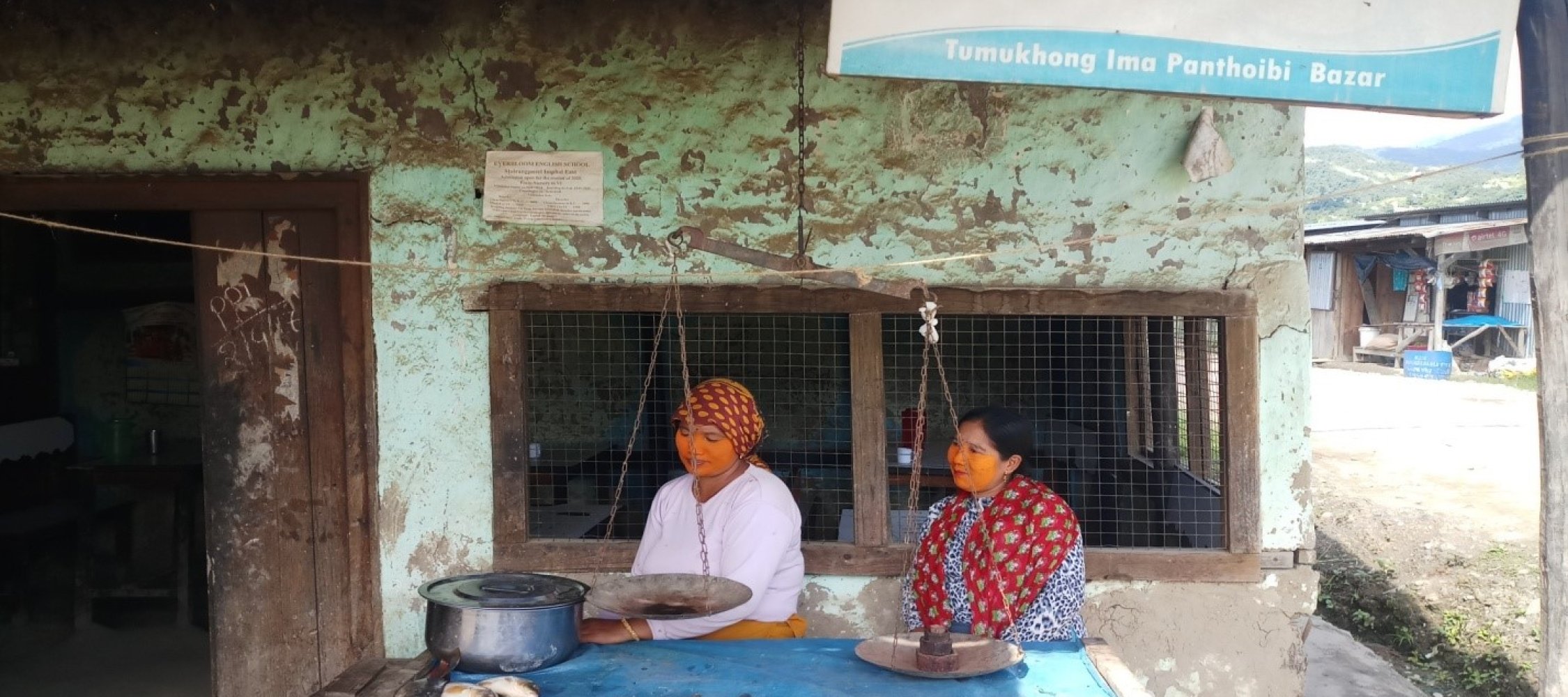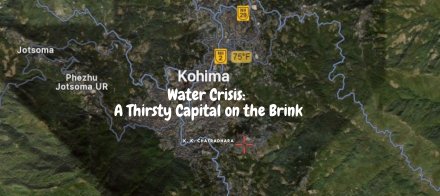 |
The people of New Chadong whom we have interacted with for this story talked about how water was abundant in their old village throughout the year. Most Tangkhul villages in the hills have a hard time fetching water from far distances between the source and the settlements. And women mostly take on the difficult task of managing water for the whole family. But this was not the case at Chadong. The streams and natural springs emerging from the pristine Mapithel forest range provided perennial freshwater for drinking and domestic uses. The water of the Mapithel (known as ‘Thoubal’ in the valley) river was also effectively used for irrigating the farmlands.
All streams flow down from Ukhrul as well as the Mapithel hill range and join the Thoubal river in the plains. Fish was so abundant that everyone had enough for domestic consumption and for sale in nearby villages or at the nearest traditional market hub at Yaingangpokpi. Different varieties of fish, snails, and lobsters like Ngaton, Ngamuleirou, Waikhu, Ngara, Khabak, Nunga, Sarengkhoibi and Tharoi were found in the Thoubal river. The catch from the Thoubal river was famous for its taste and there was a huge demand for it. So, the fish provided monetary benefits to the villagers too.
Villagers had both tam-lou (valley paddy fields) and ching-lou (hill paddy fields) and were primarily focused on agricultural activities. There was enough food for the villages, and the surplus produce was sold at Yaingangpokpi. Chadong was even known as the ‘rice bowl’ of Ukhrul. Shortage of basic necessities was unheard of in the village. Everyone who visited the village spoke of how beautiful the village was with its easy access to water and fertile land.
The Mapithel Dam project came as a rude shock to the people, which threatened to destroy the prosperous and happy community and the surrounding natural environment.
The dissatisfaction over the improper implementation of the MOATC prompted further negotiations between the state Government of Manipur, even at the level of the Chief Minister, and representatives of the affected villagers. Meanwhile, in February 2005, the anti-dam committee was renamed as Mapithel Dam Affected Villages Organisation (MDAVO), which made serious efforts to stop the multipurpose project despite the advance work on the dam. Protests, rallies, memoranda, press conferences, boycotts, etc., were held at dam sites and in the state capital. After much public pressure, in October 2007, the state government decided to constitute an Expert Review Committee to “review the present Government policy of Rehabilitation and Resettlement Programmes pertaining to the affected villages of the Mapithel area due to the construction of the Thoubal Multipurpose Project”.
It is apparent from the various exchanges between the representatives of the affected villagers and the state government that the level of participation of the affected communities in decision-making, particularly related to the conceptualisation of the dam, compensation, and their rehabilitation and resettlement plans, has been insignificant or extremely limited. That was because they were not provided with any opportunity for participation during the planning stage of the dam. The project was formulated and proposed without obtaining the free, prior, and informed consent of the affected villagers.
Moreover, the state government, instead of waiting for the report of the review panel, it opened another channel for negotiation with a new set of people from the affected villages; the government struck a separate deal with some village representatives with a proposal of a one-time payment of Rs.14 lakh per family as the final settlement. Several families accepted the proposal, while several others rejected the agreement.
That was the turning point in the popular resistance struggle at Chadong. Like all resistance stories, dams create fractures in families, clans, and villages due to many push and pull factors that usually ensue during the construction phase. Even the stiffest resistance is intentionally torn down by creating disagreements among leaders, pushing them to choose between “a no-dam position” and “a better rehabilitation package”. Even an old issue of the village becomes a bone of contention between two clans getting entangled with the dam issue, as it also has happened in the case of Chadong.
The village is now divided into three main factions: (i) Those who refused to accept the monetary package. (ii) Those who willingly and whole-heartedly took this money, and (iii) a mixed group, which agreed to move to a new settlement opposite the original village.
In other words, there are now supposedly three Chadong ‘villages’ on the upper reaches of the original village site where most of those who refused to take the rehabilitation money are settled. The new chief and the secretary live there. The second one is settled above the New Chadong site and is populated by a small group of families led by the ex-chief of the old village. And the third is the New Chadong, which has some 45 households and is headed by a chairman. The government has promised to create all the necessary amenities in this ‘officially rehabilitated’ village. And with this, Chadong, along with all its history and institutions built over the past hundreds of years, got buried under the reservoir.
As it happens in any hilly region, these tiny streams dry up during the summer, creating acute water shortage. In the monsoon months, though the water flow of these streams swells up, it is tough to access these sources due to slippery and unstable terrain. Villagers, especially women, need to struggle to get a bucket of water from the stream during the rainy season. And if the rain stopped for a few days, there would be hardly any water in the streams. There are a few perennial streams, but these are on the other side of the reservoir. During the months from February to June, the villagers are plagued with severe water scarcity. Many of them buy water at a rate of Rs.250-300 for every 500 litres to meet their domestic needs. When there is excessive rainfall, water is still a problem as the streams turn muddy.
At present, the source of water is so far that women no longer can fetch water. So it is left to the men to fetch it most of the time. The new settlement site is about a kilometre from the reservoir and can be reached only on foot. However, crossing the vast surface water of the reservoir is risky. People have taken up rainwater harvesting to cope with the water crisis, but it’s only for a few months. Even a drop of water is valued highly due to the scarcity.
Roads are as good as non-existent. Earlier, women collected firewood from the surrounding area, but now in the new settlement, the men travel long distances to collect it. So, even fetching something for household use causes a lot of hardship.
Upland farming is highly labour intensive and is solely dependent on rains. It is also based on traditional knowledge and practices, which are generally characterised by mixed cropping and low productivity. Unlike in old Chadong, the villagers in the new settlement in the upland do not have suitable land for farming. The villagers now buy vegetables from Yaingangpokpi, where they once sold their surplus; neither do they have access to fishing. Many families, who lived on fishing in the Thoubal river, have lost their livelihoods; they now buy fish from nearby fish farms.
Lack of basic amenities in the new settlement has also affected the livelihoods of the people. Relocation of the village workforce from agricultural labour to the informal sector has forced them into the marginal sector of a direct hand-to-mouth economy.
It has also been reported that the Government of Manipur and the Joint Action Committee Against Forced Construction of Mapithel Dam, Manipur (JACAFCM) and Mapithel Dam Affected Headmen/Chiefs and Elders Organisation (MDAHCEO) have reached an agreement, in which the “exclusive fishing and fish rearing rights have been accorded to the affected villages only”. This is new progress toward the long-term use and security of the villagers affected by this dam. But even then, the villagers feel that the new agreement may create fresh tension over the interpretation of certain sections of the agreement such as the “exclusive fishing and fish rearing rights” of the “affected villages only”. After all, many villages upstream and downstream of the dam have been differentially affected by the dam-induced water situations.
Well, initially, when the construction activities began, many families from Tumukhong had someone working at the project site. Some were truck drivers, while others worked as gatekeepers, security guards or just as manual labourers. The temporary workers, mostly from the farmers’ families, earned some money, and everything seemed fine.
In the meanwhile, as the dam was getting near completion by 2008, a group of people representing villages from the dam site to the downstream formed the Mapithel Dam Affected Ching-Tam Organisation (MDACTO) and sought their proper rehabilitation and resettlement. There were representatives from Tumukhong and Moirangpurel villages, too, among other downstream villages.
In its first press statement, issued on 25 May 2008, the organisation stated: “The Mapithel Dam of the Thoubal Multipurpose Project which began in early 1980 was built without the due knowledge and consent of those who live at the downstream of the dam, and also without any downstream impact assessment and accompanying Resettlement and Rehabilitation”. It also pointed out that the downstream villages – such as,Tumukhong, Moirangpurel, Moirangpurel(II), Etham, Laikhong, Bewlaland, Saichang, Molkon, Bongyang, among others – have been kept in the dark about the likely impact of the dam on the riverine ecosystems, and socio-economic and cultural relations and arrangements of those living downstream of the dam.
However, it said, “From our experiences …during the construction time we are faced with (several) problems, including air and water pollution. Our air has become dusty, making (it difficult for us) to even breathe during the peak hour construction time. Dust covered our fields, our houses and streets, and even our food. Water has become polluted and undrinkable with dust, mud, and effluents… (from) dam construction (site)”. Moreover, with the installation of the coffer dam, the downstream villages have been experiencing water shortages for irrigation and household use. Sand mining and boulder extraction activities, which are also a source of income for many, have dwindled, affecting their livelihood, it added.
The MDACTO also raised the dam safety issue, citing the Comptroller and Auditor General (CAG) report, which noted with concern, “the poor safety norms” that have been followed in the Mapithel dam construction. This also has been substantiated by testimonies of dam workers and corroborated by the recent break on the spillway wall. It is natural for downstream, responsible citizens to ask for a proper safety assessment of the dam.
Earlier in February 2008, the organisation had submitted a memorandum also to the then chief minister stating their concerns over the safety of dam and seeking his intervention. However, the government chose to remain silent and non-responsive.
“A responsible government would have immediately asked for an enquiry and a full scale safety assessment, but instead, it has threatened to arrest those who have raised this issue. A militarisation and an undemocratic mindset of the government will not only prove to be disastrous for the dam and downstream inhabitants but also a doom for the whole of Manipur,” it warned. “This is irresponsible, unaccountable, and a disregard of all democratic calls of its citizens,” it lamented.
At the same time, the MDACTO decided to take more stringent measures, including stoppage of all activities in the dam area, non-cooperation with dam authorities and eviction of dam-related people from the villages. Subsequently, a “rally cum meeting” was also held in September 2008. Alarmed by the growing discontent and protests among the affected population, the government swung into action to suppress the anti-dam campaign and arrested four executive members of the organisation.
Amidst such people’s protests, uncertainties, and non-committal government approach, dam construction continued and was completed. Although the dam has been inaugurated in 2018, it has not been fully functional for reasons known to the government. Irregularities in opening and closing the dam gates without any announcement or information have now become a source of new concerns for the downstream villagers. Once the dam gates are opened, the river is flushed with excess water, creating a man-made flash flood in its wake and causing unexpected damages to riverside agriculture and small-scale sand mining in the river bed.
Recently a person drowned in an open pit while crossing the river. The water level is maintained at a required level during the dry season when the gates remain shut and no water is released for three-four months. And during the rainy season, as and when water swells up beyond the danger mark, gates are suddenly opened to release water without any announcement or forewarning, threatening the lives and property downstream. There are even stories of men keeping night vigils on the flood situation and sleeping during the day, thereby foregoing their daily works. During the dry season, a pukhri (pond) is dug out inside the river to store water for the immediate needs.
Impacts of the dam may be different upstream and downstream, but both are heavily affected by the construction. Water released from the dam is unfit for drinking due to a strange odour – something like methane gas – in it. Decomposition of the biomass in the reservoir is said to be the reason for such stench of methane in water. Villagers also complained of skin rashes after a swim or a bath in the river.
The river was the main source of water for riverside farming and the seasonal cultivation of green vegetables. Villagers are now digging their agricultural lands along the riverside for extraction of sand and stones. But this too is going to be exhausted soon. The desperate people have started mining red sand from the surrounding hillocks despite restrictions from the forest and other government departments.
Fishing in the upstream of the dam is restricted and even if some people tried to go for fishing, it appeared to be quite a risky job for the villagers to cast their fishing nets and gears in the large area of water. Women in Manipur have always been entrepreneurs and trading has been their mainstay. When their fishing activities stopped, women in Tumukhong began to sell fish imported from outside the state. However, even this business has become very difficult and challenging following the COVID-19 pandemic.
So, the thriving local fishing economy has collapsed along with the ever famous and tasty Nung-nga fish from the Thoubal river that everyone craved for.
On the one hand, thousands of families lost their livelihoods and income, and now there is scarcity of food and water, on the other, it has created a fear psychosis in the riverine communities. In fact, the hardship of the villagers has now multiplied due to the pandemic and uncertain living conditions downstream of the dam.
“It seems the dam took away our freedom,” lamented a villager.
“Nay,” remarked another, “it took our water, our sand, our fish, and with all this, it took away our life.”
Ramananda Wangkheirakpam is the convenor of Ngamee Lup, a federation of small scale fishing unions in Manipur. He is associated with the environmental issues in the region for a long period. (wangkheilakpa@gmail.com, +917085593415)
Geolocation is 24.8553271383123, 94.14757495875506


